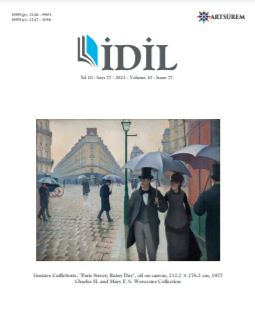GEÇ ANTİK ÇAĞ-ERKEN HIRİSTİYAN SANATINDA FİLOZOF İSA FİGÜRLERİ
CHRIST THE PHILOSOPHER FIGURES IN LATE ANTIQUE AND EARLY CHRISTIAN ART
Author(s): Ferda Barut KemirtlekSubject(s): Christian Theology and Religion, Fine Arts / Performing Arts, Visual Arts, Studies of Literature, Ancient World, 6th to 12th Centuries
Published by: Sanat ve Dil Araştırmaları Enstitüsü
Keywords: Late Antiquity; Early Christian Art; Iconography; Christ the Philosopher;
Summary/Abstract: Late Antique and Early Christian Art designates the idiosyncratic content and style of the art which was produced during the Christianity transition process of the Roman society which was nourished mostly by the ancient Greek culture. In this transition process in which the border lines were blurred and the Christian iconography was not standardized yet, the pagan elements were included to the Christian narration or the visual images which were needed by the Christians were articulated into the pagan narration. This process which was lasted between the third to sixth centuries ended by the dissolving of pagan culture into Christianity. After Christianity constructed its own content and image discourse, pagan elements disappeared except rare personifications and mythological premises of some Christian scenes of which their geneological roots cannot be settled down easily. In this period, the philosopher image, one of the prestige indications of the ancient culture, was used for Jesus depictions frequently. In ancient society the notions of morality, culture, education and philosophy were perceived as honourable and closely interrelated with each other. The philosopher figure who possesses these virtues is an educated and restained person, a wise teacher who guides the people around him by the way of his attitudes, his own life and his lectures. In relation to this perception, in Late Antique and Early Christian Art, especially on sarcophagi, Christ is depicted in the image of philosopher/teacher who leads the person to the true knowledge both in life and after-life. Christian theology has created its own sphere and conceptual framework, consequently the identity between the virtuous life and philosophy is abandoned at the end of Late Antiquity. In this milieu philosophy losts its importance, even starts to define an antitheological sphere for Christians. The philosopher image is no longer appropriate for the ones who identify it with the pagan and hence religionless Greeks of the ancient times. By losing the previous value of the philosopher’s image in ancient society, Christ the Philosopher figures have disappeared from the representations.
Journal: İdil Sanat ve Dil Dergisi
- Issue Year: 10/2021
- Issue No: 77
- Page Range: 164-175
- Page Count: 12
- Language: Turkish

